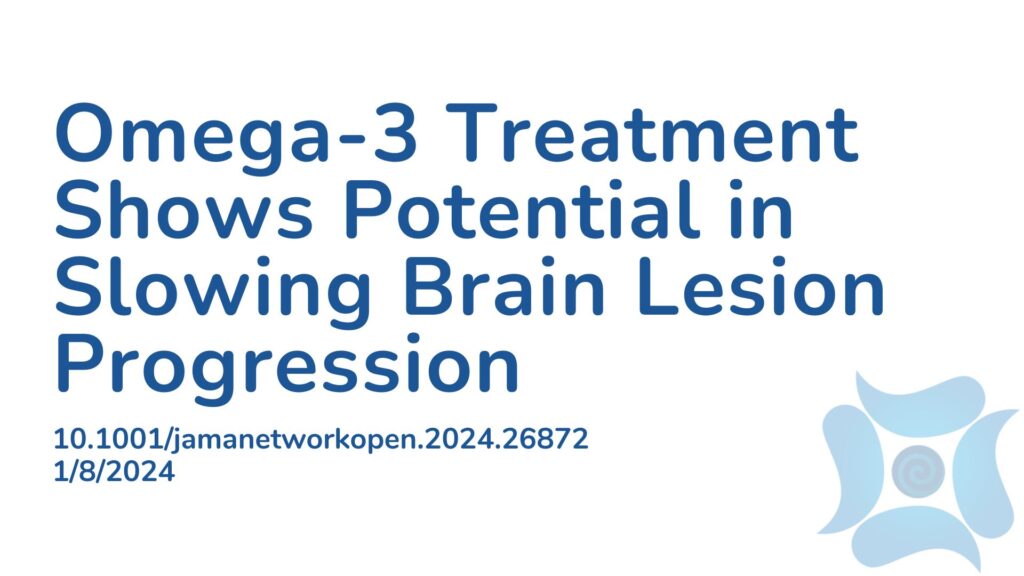Summary:
This study explored the effects of omega-3 polyunsaturated fatty acids on brain white matter lesions (WMLs) in older adults. WMLs are abnormal lesions in the brain that are often used as markers for blood vessel diseases. The older adults studied were without dementia but had existing WMLs and low omega-3 levels. The study was a randomized, quadruple-blinded trial involving 102 participants aged 75 and older. Over three years, participants received either omega-3 (EPA and DHA) or a placebo. Results indicated that omega-3 treatment led to less WML accumulation and neuronal integrity decline compared to the placebo; however, the results were not statistically significant. Among those carrying the APOE*E4 allele, a gene associated with developing dementia, omega-3 significantly reduced neuronal integrity decline. The study suggests omega-3 treatment may benefit specific subgroups, despite not showing overall significant effects.
Abstract:
Importance: Older adults with lower intake and tissue levels of long-chain ω-3 polyunsaturated fatty acids (PUFAs) eicosapentaenoic acid (EPA; 20:5) and docosahexaenoic acid (DHA; 22:6) have more brain white matter lesions (WMLs), an association suggesting that small-vessel ischemic disease, a major contributor to the development of dementia, including Alzheimer disease, may be preventable through ω-3 treatment.
Objective: To determine whether ω-3 treatment reduces WML accumulation in older adults without dementia harboring WMLs and with suboptimal ω-3 status.
Design, Setting, and Participants: This quadruple-blinded, placebo-controlled, randomized clinical trial with treatment stratification by apolipoprotein E ε4 allele (APOE*E4) carrier status used linear mixed-effects models to estimate mean annual change between groups. The study was conducted at Oregon Health & Science University, a major academic medical center in the Pacific Northwest, from May 2014 to final participant visit in September 2019. Data analysis concluded in July 2022. Participants were adults without dementia aged 75 years and older with WMLs greater than or equal to 5 cm3 and plasma ω-3 PUFA less than 5.5 weight percentage of total.
Intervention: Three-year treatment with 1.65 g of ω-3 PUFA (975 mg of EPA and 650 mg of DHA) vs a soybean oil placebo matched for taste, smell, and appearance.
Main Outcomes and Measures: The primary outcome was annual WML progression measured using magnetic resonance imaging. Secondary outcomes included diffusion tensor imaging of fractional anisotropy (DTI-FA), representing neuronal integrity breakdown. Results: A total of 102 participants (62 women [60.8%]; mean age, 81 years [range, 75-96 years]) were equally randomized, 51 per treatment group. Although the ω-3 group had less annual WML accumulation than the placebo group, the difference was not statistically significant (1.19 cm3 [95% CI, 0.64-1.74 cm3] vs 1.34 cm3 [95% CI, 0.80-1.88 cm3]; P = .30). Similarly, the ω-3 group had less annual DTI-FA decline than the placebo group, but the difference was not statistically significant (−0.0014 mm2/s [95% CI, −0.0027 to 0.0002 mm2/s] vs −0.0027 mm2/s [95% CI, −0.0041 to −0.0014 mm2/s]; P = .07). Among APOE*E4 carriers, the annual DTI-FA decline was significantly lower in the group treated with ω-3 than the placebo group (−0.0016 mm2/s [95% CI, −0.0032 to 0.0020 mm2/s] vs −0.0047 mm2/s [95% CI, −0.0067 to −0.0025 mm2/s]; P = .04). Adverse events were similar between treatment groups.
Conclusions and Relevance: In this 3-year randomized clinical trial, ω-3 treatment was safe and well-tolerated but failed to reach significant reductions in WML accumulation or neuronal integrity breakdown among all participants, which may be attributable to sample size limitations. However, neuronal integrity breakdown was reduced by ω-3 treatment in APOE*E4 carriers, suggesting that this treatment may be beneficial for this specific group.
Article Publication Date: 1/8/2024
DOI: 10.1001/jamanetworkopen.2024.26872



